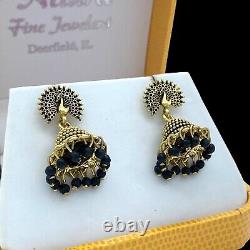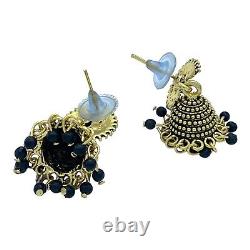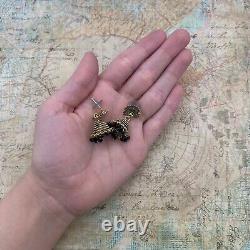
- Home
- Brand
- Art Nouveau (4)
- Bold Bloc Design (6)
- Camerden Forster (2)
- Erhard & Sohne (2)
- Grès De Charenton (2)
- Handcrafted (2)
- Handmade (7)
- Herve Lelong (6)
- Karlsbad (3)
- Kayserzinn (4)
- Makenier (3)
- Mundia (2)
- No Brand / Generic (11)
- Nsp (2)
- Rosenthal (2)
- Starling (6)
- Unknown (2)
- Villeroy & Boch (4)
- Vintage (4)
- Wilhelm Kagel (2)
- Other (3253)
- Features
- Gender
- Material
- Period
- Size
Antique Vintage Art Nouveau 14k Gold Plated Mughal Glass Wedding Earrings 8.7g





Antique Vintage Art Nouveau 14k Gold Plated Mughal Glass Wedding Earrings 8.7g. This product description was originally written in English. Please find below an automatic translation in French. If you have any questions, please contact us. We have similar Mughal and Art Nouveau items that would pair well with this piece, on sale this week. Description of the listing by: Angela A. Markings: Unmarked, tested and guaranteed. Main stone measurements/color: Color: opaque black hue. Accent stone measurements/color: Stone treatment: Glass is a man-made stone. Stones have been tested and guaranteed using a professional refractive, heat, and hardness Presidium Duo tester.
Stone sizes: Polished round glass beads. Item measurements: Earring style: Pendant.
Earring backing style: Post and rubber stopper backs. Your jeweler can easily convert them to your preferred backing style. For pierced or non-pierced ears: Pierced. These earrings were handmade in India in the style of Mughal wedding jewelry. This jewelry was popular among British soldiers stationed in India at that time.Made of 14k gold plated over base metal. Features a beautiful dome-shaped design, threaded with hanging black glass beads. The domes contain a repeated multi-level design of granulated beads. A peacock motif rests at the top of the earrings. Completed with post and rubber backs for secure wearing.
There are several chips and wear to the glass beads. The price has been reduced to reflect this.
This listing is for the item only. All display and/or photography props will not be included with your purchase. This was true due to the stunning designs that came out of this period.
This time period was inspired by the beauty of women and nature, and the resulting pieces were often large and elegant. Enamel was a commonly used material in Art Nouveau jewelry as the period was more about the importance of design over the materials used to create it. The Art Nouveau period happened before the start of the First World War, when mass production took over the production of many products, including some jewelry. Mughal jewelry emerged in India under the Mughal dynasty, starting from the 16th century. Jewelry was an important symbol indicating a person's status in society.
The elite wore highly ornate and heavily adorned jewelry pieces. As the Mughal Empire conquered the majority of India, the Mughal style spread to many other regions, being incorporated into many Indian cultures. The pieces typically feature intricate patterns, massive amounts of gemstones, and elaborate enameling.
Granulation, an ancient decorative technique where tiny grains of gold or silver are fused or soldered onto the surface of jewelry with no evidence of solder, began over five thousand years ago. In the 7th century BCE, the Etruscans perfected this art, creating complex granulated gold jewelry that were later discovered in tombs during archaeological excavations in the late 18th and 19th centuries. These discoveries sparked a renewed interest in granulation techniques, and fine granulated pieces were created during the Etruscan Revival in the 1800s. A labor-intensive process, there are several different methods that metallurgists can use to create granules, including cutting fine gold wire, heating it, and applying it to the jewelry.
This intricate decoration method continues to make granulated jewelry highly sought after today. Domestic US: All items are shipped within one business day after receipt of payment. We do not undervalue packages for customs, please do not ask us to do so. What you pay is what we will ask on your customs form. Please consider this before placing your bid.A labor-intensive process, there are several different methods that metallurgists can use to create granules, including cutting fine gold wire, heating it.

